





Filiatra is built on a fertile plain at an altitude of 80 metres and has approximately 5,900 permanent residents. It is 15 kilometres from Gargaliani, 41 from Pylos and 80 from Kalamata.
The broader area of Filiatra has been inhabited since at least 3000 BC. as traces of life have been observed since the Stone Age. This is also confirmed by the stone axes and various tools found in excavations along the river Krounoi and caves in the area. In ancient times, the area belonged to Nestor’s kingdom of Pylos, as Filiatra is considered to be the continuation of the ancient city of Erana.
According to one version, the name Filiatra comes from the Frankish baron De Filiatre. In contrast, others argue that the name comes from the many wells in the area (from the evolution of the word frear "well"). "Filiatro" means the rim of the well.
During the Venetian occupation, the then village of Filiatra was referred to as Figliatra, while after the end of the Venetian occupation and the beginning of the Turkish occupation, it became a large commercial and agricultural centre of Trifylia. The village also participated in the Greek Revolution of 1821, during which it suffered various disasters. In 1822-1823, the first school of Filiatra also operated. After the liberation and mainly from the middle of the 19th century, Filiatra became an important centre of raisin production and trade with significant European exports.
On August 27th, 1886, the town was almost completely levelled by the tremendous destructive earthquake of 7.5 degrees on the Richter scale, centred on Filiatra, creating extensive damage in Messenia and Ilia.
The Venetian fountain of the 19th century, which was commissioned in 1871 by Florence, dominates the central square of Filiatra (Kapodistrias square). Also , the Eiffel Tower (26 metres high) replica built in 1960 by doctor and sculptor Harry Fournier (Charalambos Fournarakis) stands out at the town's north-western entrance.
To the southeast of Filiatra, among olive trees, is the small cross-roofed church of the Ascension of the Savior, the oldest church of its kind in Greece. The church of Panagia of Vlacherna, which was built before 1820 and has been declared a historic monument by the Ministry of Culture, is also worth visiting.
One of the area’s most important attractions is the "Castle of Fairytales", the work and donation of the local doctor and sculptor Harry Fournier. The castle was built in the 1960s, and its outer space is decorated with scenes and statues from Greek mythology.
Saint Charalambos, honoured on February 10th with a Divine Liturgy and a great festival, is the patron saint of Filiatra. Also, every year, from mid-May to mid-June, the "Watermelon Festival" takes place, where visitors are offered watermelon from Trifylia. Finally, the social film by Theodoros Maragos, "Get Positions" (1974), which presents the gradual desolation of the city, takes place entirely in Filiatra.